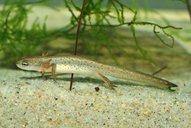|
Description
A relatively small newt with a pair of dorsolateral red stripes that extend nearly the full length of the body and tail, tending to break up on the head and tail. Stripes may be bordered with black. Short red stripes or spots may occur on the sides, and a light (not red) middorsal stripe may be present. Dorsal ground color is dark brown to olive green, sometimes with black specks. Ventral color is yellow with black specks. Dorsal and ventral colors are sharply demarcated. Adults are 2.7-4.1 cm snout to vent length (5.2-7.9 cm total length). Adult males have an orange-colored gland cluster on the posterior edge of the vent opening. Larvae are pond type with broad dorsal fins, bushy gills, and balancers when they first hatch (8 mm total length). Hatchlings have dark lateral bands that fade, being replaced by a series of light dashes on the sides as larvae mature. The juvenile eft stage is similar in color to adults, but ground color is dull orange dorsally and the skin is rougher in appearance. Some populations have both metamorphosed and gilled adults. Gilled adults are similar in coloration to metamorphosed adults, with red stripes or spots. Description from Mecham (1967), Christman and Means (1992), and Petranka (1998). Distribution and Habitat
Country distribution from AmphibiaWeb's database: United States U.S. state distribution from AmphibiaWeb's database: Florida, Georgia
Coast Plain of southeastern Georgia and northern Florida. Preferred breeding season habitat is wetlands with small ponds, drainage ditches and other standing or sluggish bodies of water. Adults and efts occur in surrounding forests the remaining portion of the year (Petranka 1998). Breeding ponds in Georgia have intact hardwood canopies surrounded by relatively mature pine forests (Dodd and LaClaire 1995). Populations are isolated and scattered, not continuous, throughout the range. Striped newts rarely occur in permanent ponds which often harbor predatory fishes (Christman and Means 1992; Petranka 1998).Life History, Abundance, Activity, and Special Behaviors
Adults migrate to breeding ponds from surrounding uplands shortly before breeding. Adults may move hundreds of meters to and from breeding sites. Movement is usually tied to periods of heavy rains when temporary ponds fill. Breeding season lasts from mid-winter through spring (Dodd 1993; Dodd 1996; Petranka 1998). Courtship has not been described in detail. Fertilization is internal by means of a spermatophore deposited on the substrate by the male and picked up by the female in her cloaca (Petranka 1998). Females attach eggs singly to aquatic plants. Oviposition occurs shortly after mating and hatching of larvae occurs approximately one month later (Christman and Means 1992; Petranka 1998). Diet includes a range of aquatic invertebrates, as well as frog eggs. Natural predators are not known, although fish are likely (Christman and Means 1992). Like other newts, N. perstriatus deters potential predators with toxic skin secretions (Petranka 1998). Trends and Threats
Populations of N. perstriatus in Florida are threatened by fisheries management practices which consist of turning temporary ponds into permanent ponds by means of blasting. This destroys the preferred aquatic habitat of the newts, and permits permanent populations of gamefish (bass and bluegill) which are predators of newts and larvae (Christman and Means 1992). Classified as Rare in Florida due to the patchy distribution in isolated wetlands and ponds. Local populations are vulnerable to extirpation due to development (Christman and Means 1992). The Rare status implies that populations not currently endangered or threatened are at risk due to restricted ranges or patchy distribution, both of which apply to N. perstriatus (Moler 1992). Populations in Georgia have been eliminated by the conversion of native longleaf pines into intensively managed slash pine plantations, as well as conversion of native forests into agricultural lands (Dodd and LaClaire 1995). Protection of forested areas surrounding aquatic breeding sites is necessary to preserve the terrestrial habitat of efts and adults (Dodd 1996). Comments
Genetically, N. peristriatus is more closely related to N. meridionalis than to N. viridescens (Reilly 1990).
References
Christman, S. P., and Means, D. B. (1992). ''Striped Newt.'' Rare and Endangered Biota of Florida. Volume 3. Amphibians and Reptiles. Moler, P. E., eds., University Press of Florida, Gainesville, FL, 62-65.
Dodd, C. K., Jr. (1993). "Costs of living in an unpredictable environment: The ecology of striped newts Notophthalmus perstriatus during a prolonged drought." Copeia, 1993, 605-614.
Dodd, C. K., Jr. (1996). "Use of terrestrial habitats by amphibians in the Sandhill Uplands of north-central Florida." Alytes, 14, 42-52.
Dodd, C. K., Jr. and LaClaire, L. V. (1995). ''Biogeography and status of the striped newt (Notophthalmus perstriatus) in Georgia, USA.'' Herpetological Natural History, 3, 37-46.
Mecham, A. S. (1967). ''Notophthalmus perstriatus (Bishop). Striped Newt.'' Catalogue of American Amphibians and Reptiles. American Society of Ichthyologists and Herpetologists, 38.1-38.2.
Moler, P. E. (ed.) (1992). Rare and Endangered Biota of Florida. Volume 3. Amphibians and Reptiles. University Press of Florida
Petranka, J. W. (1998). Salamanders of the United States and Canada. Smithsonian Institution Press, Washington D.C. and London.
Reilly, S. M. (1990). "Biochemical systematics and evolution of the eastern North American newts, genus Notophthalmus (Caudata: Salamandridae)." Herpetologica, 46, 51-59.
Originally submitted by: Meredith J. Mahoney (first posted 2000-07-28)
Edited by: M. J. Mahoney (2001-05-09)Species Account Citation: AmphibiaWeb 2001 Notophthalmus perstriatus: Striped Newt <https://amphibiaweb.org/species/4264> University of California, Berkeley, CA, USA. Accessed Jun 9, 2025.
Feedback or comments about this page.
Citation: AmphibiaWeb. 2025. <https://amphibiaweb.org> University of California, Berkeley, CA, USA. Accessed 9 Jun 2025.
AmphibiaWeb's policy on data use.
|





 Raffaëlli Account
Raffaëlli Account Map of Life
Map of Life